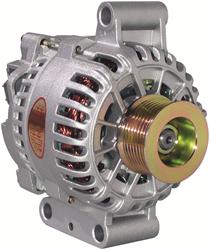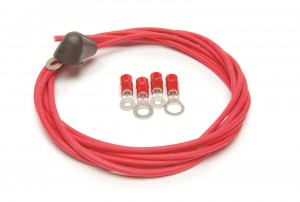what is needed for a 105 amp to 200 amp alternator upgrade

In that location are plenty of good reasons to make the spring to a loftier-output alternator, only you lot'll need to do a little bit of homework kickoff. Luckily, we've got smart friends to help us with our studies, and then you can ace the topic. In conjunction with the alternator experts at Powermaster and MSD, we've compiled the five things you need to know before upgrading to a high-amp, or high-output alternator.
This starts with the most basic of questions:
Practise You Really Need a High-Output Alternator?
If you've got a bones, stock vehicle, chances are yous don't need a high-output alternator. Near mill alternators are rated at 65 to 100 amps and are capable of handling your vehicle'southward basic necessities, such as headlights, gauges, fuel pumps, A/C, etc. These alternators also typically come with a ten to xv percent reserve to handle additional accessories.
All the same, many of our readers don't have a stock vehicle. For example, you may have a custom-congenital street rod with a unique combination of accessories. Or you may take a high-end stereo system or a race vehicle with an assortment of on-board electronics. As the electrical load of all these accessories add together up, yous may observe yourself in demand of a higher-amperage alternator.
But how do y'all know?
There are a few ways to figure out whether you demand to upgrade your alternator. A few telltale signs are dim headlights, poor stereo arrangement operation, or an alternator that merely wears out apace. You can also bank check your electric load using an ammeter. Merely connect the ammeter in series with the battery'southward ground concluding (with the engine turned off), switch each electrical component on and off, and note their amperage draws. Add together up the full electric depict and compare with your alternator'southward rated output. The output should be 50 pct greater than the draw.
One last manner to guess your vehicle's electrical load is to cheque the accessory fuses. The amp ratings, although slightly higher than the highest draw of each component, will requite y'all a good estimate of your vehicle's electrical load.
What Amperage Practice Yous Need?
That depends on the current draw, forth with any futurity accessories you plan to add. For that reason, we've supplied a list of some common accessories and their amp depict:
Electrical Load of Common Vehicle Accessories
| Accessory | Amp Describe |
|---|---|
| Air Conditioner | 20-21 |
| Audio Ability Amplifiers | 10-70 |
| Back-Up Lamps | iii-4 |
| Cigarette Lighter | 10-12 |
| CD/Tuner with Amp | 7-xiv |
| CD/Histrion/Tuner without Amp | ii.v-v |
| Clock | 0.iii |
| Dome Light | 1-2 |
| Electrical Cooling Fans | half dozen-15 |
| Head Lamp Dimmer | 2 |
| Caput Lamp (Depression Beam) | eight-10 |
| Caput Lamp (Loftier Beam) | 13-15 |
| Heater Defroster | 6-xv |
| Horn | 10-twenty |
| Ignition | one.5-4 |
| Ignition (Racing) | eight-36 |
| Instrument Panel | 0.vii-1.5 |
| Lamp, Gauges | 1.5-3.5 |
| Lamps, License Plate | 1.5-2 |
| Lamps, Parking | 1.five-two |
| Lamps, Side Marker | 1.iii-three |
| Lamps, Tail | 5-seven |
| Nitrous Oxide Solenoid | 5-8 |
| Power Windows Defroster | i-30 |
| Power Seats | 25-fifty |
| Power Windows | 20-30 |
| Power Antenna | 6-10 |
| Pumps, Electrical Fuel | 3-eight |
| Starter Solenoid | 10-12 |
| Voltage Regulators (ane Wire) | 0.3-0.5 |
How Much is Too Much?
You can never take as well much amperage when it comes to alternators; therefore, you never take to worry near choosing an alternator with too loftier of a rated output. Hither's why:
Amperage is basically the amount of electrical current your alternator can supply. And it basically operates off of supply and demand. That is, your alternator volition only supply the amount of amperage a particular component demands—and no more. So loftier-output alternators will non harm your components or charging system, no thing how high yous get with the amps.
 What Gauge Wire Do You Need?
What Gauge Wire Do You Need?
A performance alternator really doesn't require much in the way of modifications. Still, Powermaster and other alternator manufacturers do recommend you replace both the ground straps and charge wire. Continue in mind the manufactory cables weren't designed to handle the juice of a college-output alternator, and tin can restrict the flow of electricity.
In the case of the charge wire, you actually can't get as well big. However, here is a chart that matches cable gauge size to full amperage:
What is Pulley Ratio (and Why Should You Care)?
In short, pulley ratio is a comparison between the crankshaft pulley diameter and alternator caster diameter. This ratio is derived by dividing the crank pulley bore by the alternator pulley. For instance, a six-inch crank pulley with 2-inch alternator pulley will yield a iii:1 pulley ratio.
The ratio has a direct effect on how fast the alternator spins.
In gild to empathize the importance of pulley ratio, you get-go need to sympathize the "power curve" involved with alternator output. Although the alternator's output is dependent upon engine speed, information technology follows a unique curve. At idle, small changes in the alternator'south speed can brand a big deviation, then the pulley ratio becomes very of import.
Powermaster supplies its alternators with pulleys matched to the alternator's power bend. The company follows this common dominion of thumb:
- Street use = 3:1 ratio or slightly college
- Drag racing = 1.75:1 ratio
- Circle track = 1:one ratio
And so why should yous care?
Because differing ratios can touch performance, you should take care to maintain the same caster ratio if you decide to employ wearing apparel-upwards pulley sets. A mismatched pulley ratio and alternator can pb to big problems, specially at idle where alternator performance is disquisitional. That's because these high-amp units typically lose output nether 2,400 rotor rpm. Rotor rpm are a cistron of caster ratio multiplied past engine speed. So, if you have a pulley ratio of 2:1 multiplied past an engine speed of 870, you'll become a rotor rpm of 1,827.
At i,827 rpm, you lot'll encounter a significant drop in alternator output.
Again, the platonic ratio depends on your application (street, elevate racing, circle track racing), but you need to understand the effects of altering pulley ratio.
With all this in mind, you're prepare to choose the right alternator for your application.
Source: https://www.onallcylinders.com/2015/03/27/alt-text-5-things-you-should-know-before-using-a-high-output-alternator/
 What Gauge Wire Do You Need?
What Gauge Wire Do You Need?